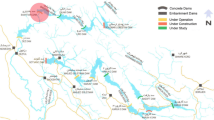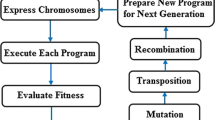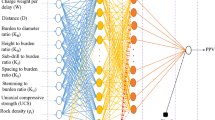Abstract
The advent of advanced computer programs, artificial intelligence techniques, algorithms, and numerical modelling techniques and their application in the mining industry, especially in the blasting field, has increased the efficiency of estimating outcomes (such as Back break and ground vibration). These blasting hazards have led to increased blasting costs and decreased the mine’s operational efficiency. This study has chosen blast design parameters to formulate a back break and ground vibration prediction equation. The formulated equations using Genetic programming used more parameters than those used by empirical equations to estimate ground vibration. The back break and ground vibration equations used significant parameters to estimate the results. The training and validation R2 (coefficient of determination) for ground vibration was 0.8752 and 0.8527, and the back break was 0.8347 and 0.8434, respectively.



Similar content being viewed by others
Data Availability
Enquiries about data availability should be directed to the authors.
References
Agrawal H, Mishra AK (2019) Modified scaled distance regression analysis approach for prediction of blast-induced ground vibration in multi-hole blasting. J Rock Mech Geotech Eng 11:202–207
Ak H, Iphar M, Yavuz M, Konuk A (2009) Evaluation of ground vibration effect of blasting operations in a magnesite mine. Soil Dyn Earthquake Eng 29(4):669–676
Ambraseys NN, Hendron AJ (1968) Dynamic behaviour of rock masses. Wiley
AminShokravi A, Eskandar H, Derakhsh AM et al (2018) The potential application of particle swarm optimization algorithm for forecasting the air-overpressure induced by mine blasting. Eng Comput 34:277–285
Arthur CK, Bhatawdekar RM, Mohamad ET et al (2022) Prediction of blast-induced ground vibration at a limestone quarry: an artificial intelligence approach. Appl Sci. https://doi.org/10.3390/app12189189
Badal KK (2010) Blast vibration studies in surface mines. BS Thesis Department of Mining Engineering, National Institute of Technology Rourkela
Barkhordari MS, Armaghani DJ, Fakharian P (2022) Ensemble machine learning models for prediction of flyrock due to quarry blasting. Int J Environ Sci Technol 19:8661–8676
Bartley DA, McClure R, Trousselle R (2003) Electronic detonator technology in open pit mining. Explosives and blasting technique. CRC Press, pp 180–187
Bhagat NK, Rana A, Mishra AK et al (2021) Prediction of fly-rock during boulder blasting on infrastructure slopes using CART technique. Geomat Nat Hazards Risk 12:1715–1740. https://doi.org/10.1080/19475705.2021.1944917
Brent GF, Smith GE, Lye GN (2002) Studies on the effect of burden on blast damage and the implementation of new blasting practices to improve productivity at KCGMs Fimiston Mine. Fragblast 6:189–206
Central Mining Research Institute (CMRI) (1993) “Vibration standards”. CMRI, Dhanbad
Ebrahimi E, Monjezi M, Khalesi MR, Armaghani DJ (2016) Prediction and optimization of back-break and rock fragmentation using an artificial neural network and a bee colony algorithm. Bull Eng Geol Environ 75:27–36
Eloranta J (2003) Characterization of the pre and post blast environments. In: Proceedings of the annual conference on explosives and blasting technique. ISEE; 1999, pp 263–272
Faradonbeh RS, Armaghani DJ, Monjezi M, Mohamad ET (2016) Genetic programming and gene expression programming for flyrock assessment due to mine blasting. Int J Rock Mech Min Sci 88:254–264
Garai D, Agrawal H, Mishra AK, Kumar S (2018a) Influence of initiation system on blast-induced ground vibration using random forest algorithm, artificial neural network, and scaled distance analysis. Math Model Eng Probl 5:418–426
Garai D, Mishra AK, Kumar S, Agrawal H (2018b) Development of a universal blast-induced ground vibration prediction model for Jharia coalfields. Model Meas Control C. https://doi.org/10.18280/mmc_c.790205
Gates WCB, Ortiz LT, Florez RM (2005) Analysis of rockfall and blasting backbreak problems, US 550, Molas Pass, CO. In: Alaska Rocks 2005, The 40th US symposium on rock mechanics (USRMS). American Rock Mechanics Association
Ghasemi E (2017) Particle swarm optimization approach for forecasting backbreak induced by bench blasting. Neural Comput Appl 28:1855–1862
Ghasemi E, Kalhori H, Bagherpour R (2016) A new hybrid ANFIS–PSO model for prediction of peak particle velocity due to bench blasting. Eng Comput 32:607–614
Ghosh A, Daemen JK (1983) “A simple new blast vibration predictor”. Proceedings of the 24th U.S. Symposium of Rock Mechanics, Texas, USA, pp 151–161
Harandizadeh H, Armaghani DJ (2021) Prediction of air-overpressure induced by blasting using an ANFIS-PNN model optimized by GA. Appl Soft Comput. https://doi.org/10.1016/j.asoc.2020.106904
Hasanipanah M, Monjezi M, Shahnazar A et al (2015) Feasibility of indirect determination of blast induced ground vibration based on support vector machine. Measurement 75:289–297
Hasanipanah M, Bakhshandeh Amnieh H (2021) Developing a new uncertain rule-based fuzzy approach for evaluating the blast-induced backbreak. Eng Comput 37:1879–1893. https://doi.org/10.1007/s00366-019-00919-6
Himanshu VK, Roy MP, Mishra AK et al (2018) Multivariate statistical analysis approach for prediction of blast-induced ground vibration. Arab J Geosci 11:460
Hudaverdi T (2012) Application of multivariate analysis for prediction of blast-induced ground vibrations. Soil Dyn Earthq Eng 43:300–308
IS 6922 (1973) Criteria for safety and design of structures subject to underground blast. Bureau of Indian Standards (BIS), New Delhi, India
Jimeno CL, Jimeno EL, Carcedo FJA, De Ramiro YV (1995) Drilling and blasting of rocks, geomining technological institute of Spain. Rotterdam, AA Balkema, Netherlands
John H (1992) Holland. Genetic algorithms. Sci Am 267:44–50
Kahriman A (2002) Analysis of ground vibrations caused by bench blasting at Can Open-pit Lignite Mine in Turkey. Environ Geol 41:653–661
Kahriman A (2004) Analysis of parameters of ground vibration produced from bench blasting at a limestone quarry. Soil Dyn Earthquake Eng 24(11):887–892
Kahriman A, Ozer U, Aksoy M, Karadogan A, Tuncer G (2006) Environmental impacts of bench blasting at Hisarcik Boron open pit mine in Turkey. Environ Geol 50(7):1015–1023
Koçaslan A, Yüksek AG, Görgülü K, Arpaz E (2017) Evaluation of blast-induced ground vibrations in open-pit mines by using adaptive neuro-fuzzy inference systems. Environ Earth Sci 76:57
Konya CJ (2003) Rock Blasting and overbreak control, National Highway Institute, USA, FHWA-HI-92-001.
Koza JR (1994a) Genetic programming II. MIT Press, Cambridge
Koza JR (1994b) Genetic programming as a means for programming computers by natural selection. Stat Comput 4:87–112. https://doi.org/10.1007/BF00175355
Kumar S, Choudhary BS (2019) Prediction of blast-induced ground vibration by ANN, USBM and CMRI formulae for safety of the structures near surface coal mines. J Mines Met fuels 67:351–356
Kumar R, Choudhury D, Bhargava K (2016) Determination of blast-induced ground vibration equations for rocks using mechanical and geological properties. J Rock Mech Geotech Eng 8:341–349. https://doi.org/10.1016/j.jrmge.2015.10.009
Kumar S, Mishra AK, Choudhary BS (2017) Study of P and S wave velocity of rocks in Jharia coalfield region for assessment of its geotechnical properties in Dry, semi-saturated and saturated conditions. In: Annales de chimie-science des matériaux, vol 41, No. 3–4, pp 209–223. https://doi.org/10.3166/acsm.41.209-223
Kumar S, Mishra AK, Choudhary BS et al (2020) Prediction of ground vibration induced due to single hole blast using explicit dynamics. Min Metall Explor. https://doi.org/10.1007/s42461-019-00162-z
Kumar S, Singh B, Arvind C, Mishra K (2021) Modelling the effects of ground vibrations on the surface due to blasting in underground coal mines. Nat Hazards doi. https://doi.org/10.1007/s11069-021-04948-7
Kumar S, Mishra AK, Choudhary BS (2022) Prediction of back break in blasting using random decision trees. Eng Comp 38(Suppl 2):1185–1191. https://doi.org/10.1007/s00366-020-01280-9
Lin B, Wei X, Junjie Z (2019) Automatic recognition and classification of multi-channel microseismic waveform based on DCNN and SVM. Comput Geosci 123:111–120. https://doi.org/10.1016/J.CAGEO.2018.10.008
Lu W, Yang J, Chen M, Zhou C (2011) Simulation modelling practice and theory an equivalent method for blasting vibration simulation. Simul Model Pract Theory 19:2050–2062. https://doi.org/10.1016/j.simpat.2011.05.012
Ma GW, Hao H, Zhou YX (1998) Modeling of wave propagation induced by underground explosion. Comput Geotech 22:283
Mesec J, Kovač I, Soldo B (2010) Estimation of particle velocity based on blast event measurements at different rock units. Soil Dyn Earthquake Eng 30(10):1004–1009
Mishra AK, Nigam YK, Singh DR (2017) Controlled blasting in a limestone mine using electronic detonators: a case study. J Geol Soc India 89:87–90. https://doi.org/10.1007/s12594-017-0563-5
Monjezi M, Dehghani H (2008) Evaluation of effect of blasting pattern parameters on back break using neural networks. Int J Rock Mech Min Sci 45:1446–1453
Monjezi M, Rezaei M, Yazdian A (2010) Prediction of backbreak in open-pit blasting using fuzzy set theory. Expert Syst Appl 37:2637–2643
Monjezi M, Khoshalan HA, Varjani AY (2012) Prediction of flyrock and backbreak in open pit blasting operation: a neuro-genetic approach. Arab J Geosci 5:441–448
Monjezi M, Hashemi Rizi SM, Majd VJ, Khandelwal M (2014) Artificial neural network as a tool for backbreak prediction. Geotech Geol Eng 32:21–30. https://doi.org/10.1007/s10706-013-9686-7
Nicholls HR, Charles FJ, Duvall WI (1971) Blasting vibrations and their effects on structures. U.S. Department of the Interior, Bureau of Mines
Nicholson RF (2005) Determination of blast vibrations using peak particle velocity at Bengal Quarry, in St Ann, Jamaica. MS Thesis, Department of Civil and Environmental Engineering, Division of Rock Engineering, Lulea University of Technology, Lulea, Sweden
Oliver PH (2003) Changes to drill pattern and adequate inter-row delay time improve blasting performance. CIM Bull 96:60–65
Ozer U (2008) Environmental impacts of ground vibration induced by blasting at different rock units on the Kadikoy–Kartal metro tunnel. Eng Geol 100(1–2):82–90
Pal Roy P (1991) Vibration control in an opencast mine based on improved blast vibration predictors. Mining Sci Technol 12(2):157–165
Paventi M, Lizotte Y, Scoble M, Mohanty B (1996) Measuring rock mass damage in drifting. Mohanty (ed.) Rock Fragm by Blasting, pp 131–138
Persson P-A, Holmberg R, Lee J (1993) Rock blasting and explosives engineering. CRC Press
Rai R, Singh TN (2004) A new predictor for ground vibration prediction and its comparison with other predictors. Indian J Eng Mat Sci, 11:178–184
Rai R, Shrivastva BK, Singh TN (2005) Prediction of maximum safe charge per delay in surface mining. Trans Ins Mining Metal Section A: Mining Technol 114(4):227–231
Saghatforoush A, Monjezi M, Faradonbeh RS, Armaghani DJ (2016) Combination of neural network and ant colony optimization algorithms for prediction and optimization of flyrock and back-break induced by blasting. Eng Comput 32:255–266
Sharma M, Agrawal H, Choudhary BS (2022) Multivariate regression and genetic programming for prediction of backbreak in open-pit blasting. Neural Comput Appl 34:2103–2114. https://doi.org/10.1007/s00521-021-06553-y
Singh SP (1993) Prediction and determination of explosive induced damage. In: International symposium on rock fragmentation by blasting, pp 183–192
Siskind DE, Stagg MS, Kopp JW, Dowding CH (1980) Structure response and damage produced by ground vibration from surface mine blasting. U.S. Department of the Interior, Bureau of Mines
Stagg K, Wiley J (eds) (1968) Rock mechanics in engineering practice, Wiley, London, pp 203–207
Trivedi R, Mudgal K, Gupta N (2014) Application of artificial neural network for blast performance evaluation. Int J Res Eng Technol 3(5):564–574
Wu C, Lu Y, Hao H (2004) Numerical prediction of blast-induced stress wave from large-scale underground explosion. Int J Numer Anal Methods Geomech 109:93–109. https://doi.org/10.1002/nag.328
Yang X-S (2021) Genetic algorithms. Nature-inspired optim algorithms, pp 91–100. https://doi.org/10.1016/B978-0-12-821986-7.00013-5
Yu TR, Vongpaisal S (1996) New blast damage criteria for underground blasting. CIM Bull 89:139–145
Zangoei A, Monjezi M, Armaghani DJ et al (2022) Prediction and optimization of flyrock and oversize boulder induced by mine blasting using artificial intelligence techniques. Environ Earth Sci 81:359
Zou D (2016) Theory and technology of rock excavation for civil engineering. Springer
Funding
The authors declare that no funds, grants, or other support were received during the preparation of this manuscript.
Author information
Authors and Affiliations
Contributions
SK: Data Collection, Manuscript writing, Paper Content. AKM & BSC: Discussion on manuscript.
Corresponding author
Ethics declarations
Conflict of interest
The authors have no relevant financial or non-financial interests to disclose.
Additional information
Publisher’s Note
Springer Nature remains neutral with regard to jurisdictional claims in published maps and institutional affiliations.
Rights and permissions
Springer Nature or its licensor (e.g. a society or other partner) holds exclusive rights to this article under a publishing agreement with the author(s) or other rightsholder(s); author self-archiving of the accepted manuscript version of this article is solely governed by the terms of such publishing agreement and applicable law.
About this article
Cite this article
Kumar, S., Mishra, A.K. & Choudhary, B.S. Estimation Equations for Back Break and Ground Vibration Using Genetic Programming. Geotech Geol Eng 41, 3139–3149 (2023). https://doi.org/10.1007/s10706-023-02449-x
Received:
Accepted:
Published:
Issue Date:
DOI: https://doi.org/10.1007/s10706-023-02449-x




